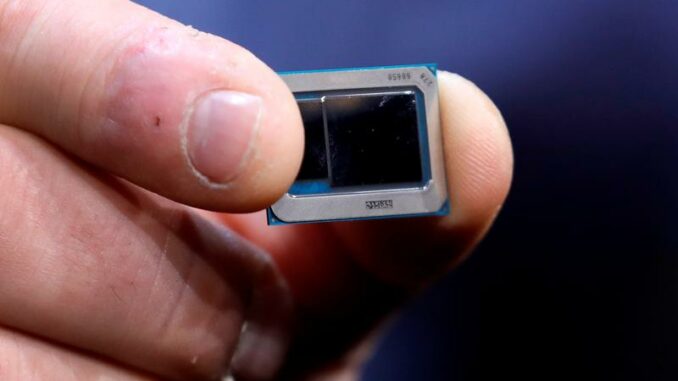
(Reuters) – Intel Corp on Thursday forecast first-quarter revenue and profit above Wall Street expectations, continuing to benefit from high demand for laptops, PCs and servers that have powered the shift to working and playing from home.
Shares rose 6.5% during regular trade, when the results were released ahead of the close. They later fell about 1.5% in after hours trading.
Intel said fourth-quarter sales from its PC chip business were $10.9 billion, compared with analyst estimates of $9.57 billion, according to FactSet data. Data center group sales, which powered Intel’s growth over the past several years, were $6.1 billion compared with analyst estimates of $5.48 billion, according to FactSet data.
Fourth-quarter revenues and adjusted earnings per share both topped Wall Street targets, according to IBES data from Refinitiv. The company also raised its dividend by 5%.
Intel’s Chief Financial Officer George Davis told Reuters in an interview that the company’s 10-nanometer chip production volume will be larger than its 14-nanometer chip production volume in the second half of 2021. Intel had previously told investors that the crossover point would happen this year but did not say when.
Intel, for decades the biggest maker of computing chips for data centers and PCs, is grappling with technology delays in its manufacturing operations and said in July it was debating whether to outsource more of its 2023 product lineup. Executives are expected to give details of the decision on a conference call at 5 p.m. ET today.
The company last week named Pat Gelsinger of VMware Inc as its incoming chief executive effective Feb. 15 and on Thursday did not give a full-year sales forecast as it has in years past.
Intel is one of the few remaining semiconductor companies that both designs and manufactures its products, with rivals such as Advanced Micro Devices long ago having turned to outside contract factories such as Taiwan Semiconductor Manufacturing Co to make their chips.
After struggling with delays with its 10-nanometer chipmaking technology, Intel lost its lead in making the smallest most power efficient chips to TSMC and Samsung Electronics Co Ltd. Analysts believe setbacks to Intel’s next generation of 7-nanometer chipmaking technology disclosed in July all but ensured the gap could persist for years to come.
Intel regained some momentum in the PC market, with volumes of PC chips rising 33%, a greater increase than the overall PC market shipment rise of 26% in the same quarter, according to data from IDC. It had released new “Tiger Lake” chips for high-end PCs for the holiday shopping season.
While Intel’s data center unit beat expectations, chip volumes declined 9%, driven by a dropoff in purchases by cloud computing service providers.
The chipmaker said it expects fiscal first-quarter adjusted sales of $17.5 billion and adjusted earnings per share of $1.10. Analysts average estimates were for $16.06 billion revenue and 93 cents earnings per share, according to IBES data from Refinitiv.
The company reported fourth-quarter revenue of $20 billion, beating estimates of $17.5 billion. Adjusted earnings per share in the fourth quarter of $1.52 topped the analyst consensus of $1.10.
Source: Read Full Article